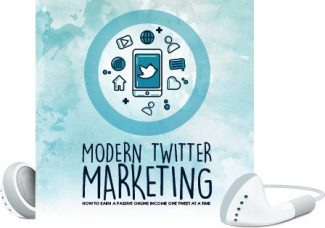 License Type: Master Resell Rights
License Type: Master Resell Rights  File Type: ZIP
File Type: ZIP
 SKU: 64134
SKU: 64134  Shipping: Online Download
Shipping: Online Download
Sample Content Preview
Make no mistake, if you believe in certain myths, you’ll end up sabotaging yourself. This applies across the board. This doesn’t just apply to marketing and definitely doesn’t just apply to social media marketing.
If you believe in myths regarding your productivity, your ability to produce stuff on time suffers. If you believe in myths regarding your self-esteem or selfconfidence, you’ll end up suffering on so many different levels.
Myths lead you to a dead end. It’s a good idea to get rid of them so you can get better results. Unfortunately, it’s one thing to say that you should overcome myths, it's another to actually do something about them.
The biggest part of the challenge is identifying the myths in the first place.
When it comes to twitter marketing, here are 10 myths that you need to identify, confront, and overcome.
Just because you put up a Twitter account doesn’t necessarily mean you will get a ton of traffic from Twitter. In fact, according to the intensive analysis done by digital marketing firms, Twitter actually sends only a small fraction of the exposures it gets. This means that, even a lot of your twitter followers retweet your material, very few people click through.
This is why it’s crucial that you get retweeted a lot, so that the volume of those retweets can compensate the fact that few people click through. Without heavy visibility—as far as retweets go—you shouldn’t really expect a huge volume of visitors from Twitter.
This makes a lot of sense because Twitter is actually swimming in millions upon millions of twits every single day. It’s very easy for these twits to fall between the cracks. Massive retweets enable your content to overcome this statistical disadvantage.
A lot of people are under the impression that Twitter is simply a branding platform. It’s great to have your content in front of people’s eyeballs so they can see the title. It’s great to see your brand and your pictures on twitter— but that’s pretty much it.
These two lines of thought are inaccurate. Twitter can deliver traffic. Just don’t expect a massive amount. But it can deliver and—if you play your cards right—it can deliver qualified traffic.
This is a big deal because when traffic is qualified, these people know what they’re clicking on and they’re clear as to what their needs are. If the content they land on addresses those needs, there’s a big chance these people would actually convert into buyers or list of members or something else.
Regardless of how you convert traffic into cold hard cash, you have a higher chance of doing that if your traffic is qualified. Twitter can be a great source of qualified traffic. Numerically speaking, it may not be much, but success in online marketing is measured by conversions, not necessarily traffic volume.
If you know how to use Twitter, chances are, you will be able to drive traffic from this platform. It’s easy to think that this is the only benefit you would get.
It turns out that Twitter actually brings a lot of benefits to the table. Not only can it drive direct visitors to your target website, it can also help you get more backlinks for SEO purposes. It can also help you become an instant expert in your niche field.
It brings a lot of benefits to the table. You just have to be open minded about it. You also have to put in the time, as far as engagement is concerned.
Don’t hang your hat on traffic. Traffic alone is not going to put dollars in your pocket. You have to qualify that traffic. This is one of the most powerful benefits of twitter because you qualify that traffic by building up your brand, credibility, and authority.
In the early days of Twitter, lots of marketers managed to pump a lot of traffic from Twitter. It turned out that the huge percentage of this traffic simply doesn’t convert. This doesn’t mean that the traffic is fake. It’s not like all this traffic came from software. That wasn’t the problem.
The problem was, the people-driving all this heavy traffic volume-didn’t bother to qualify that traffic. In fact, a lot of them tricked people into clicking on a link.
I don’t know about you, but if I got tricked into clicking on a link through click-bait or some other cheap trick, I won’t exactly be in the mood to buy something. I wouldn’t be pumped up to sign up to some sort of mailing list. Because in the back of my head, I’d be thinking “I got tricked!”. I was expecting something, and I ended up in a place that did not deliver on my expectations.
If you drive real traffic, and you qualify through content, the right hashtags and branded twitter page, chances are, that traffic can convert. Twitter traffic does convert, you just have to know what you’re doing. You can’t just focus on a massive amount of traffic and expect—somehow, someway—for people to sign up. It doesn’t work that way.
A lot of marketers think that the global traffic pie is fixed, and that there’s only so much to go around. According to this thinking, if you want your slice of the twitter traffic pie to get bigger, you have to necessarily elbow into your competitors’ slice.
Put simply, for your slice of traffic to get bigger, their slice has to get smaller. After all, there’s only so much to share. This is wrong. There is such a thing as increasing the size of the pie.
Unfortunately, a lot of people are under the impression that reaching out to people who are already authorities—or are credible figures on twitter— regarding their niche, means that they are basically making a deal with the enemy.
They view these people—who are competing for the same traffic—as opponents. This really is too bad because there’s lots more money and traffic that can be generated from cooperation instead of competition.
Don’t get me wrong, competition is good, competition lights a fire on people’s behinds and pushes them to do their best. Competition ignites your fire in the belly and pushes you to the limit. You’re pushed to be more creative. You are challenged to be more resourceful.
This enables you to come up with better solutions and beat your competition today. Subsequently, they might come up with something better tomorrow, which means that you have to step up.
That’s what’s so awesome about competition. It pushes people to perform. They can’t get lazy. They can’t expect to coast on their past victories. That simply is not an option. As a result, everybody is better for it.
- License: Master Resell Rights
- Category:Ebooks
- Tags:2021 Ebooks With Audio Master Resale Rights








